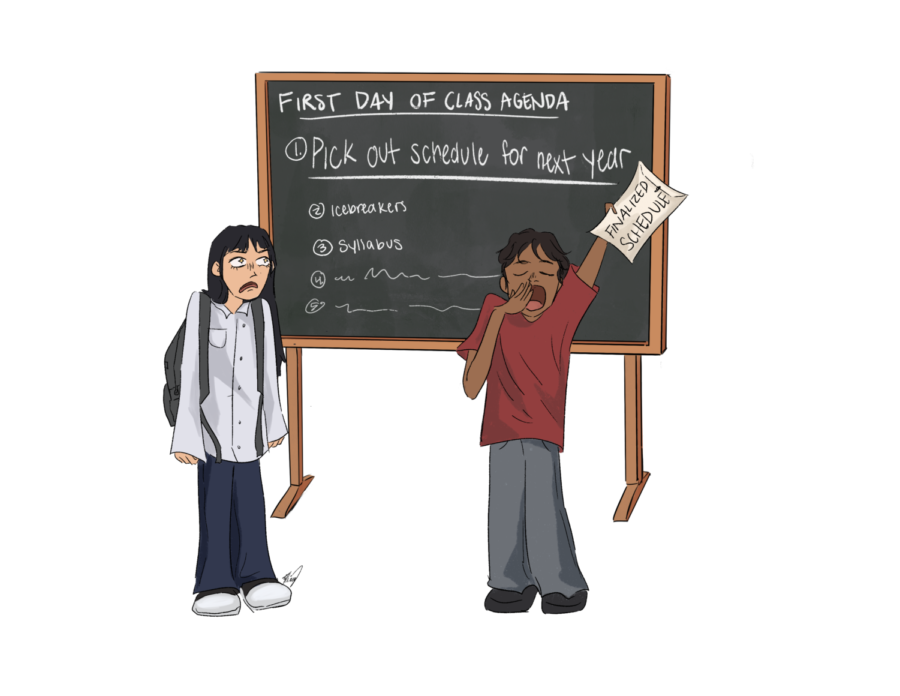Course request is now due in February
Two writers share their opinions on new CRF policy
January 26, 2023

I want to know my schedule early
It’s too early to determine my schedule
Zeina Nicolas
Cora Reyes-Castelloe
Visuals Editor
Staff Writer
I filled out the Course Request Form (CRF) last March dutifully and blissfully ignorant to the chaos that would ensue. My neatly written-out schedule, so pristine and calculated after many pros-and-cons lists—not to mention the conversations with my parents, friends, and counselor—had no chance against the higher powers that were at work. I went into the following summer believing the classes I’d chosen would be available to me, and upon returning to school in August for registration, I was confronted with the cold hard truth: two of the classes I’d chosen (AP French and Writing Seminar) would not be available, and instead were replaced by two alternates, which I really hadn’t been all that interested in taking (Psychology 1-2 and Drama 1-2). It seemed that my junior year schedule was fraught.
Although I had an unpleasant experience with last year’s course requests, there is a new CRF system being implemented this year that, hopefully, will make things different for myself and other students. The plan, proposed by staff members Teri Heard and Kimberly Carroll, involves beginning the process in late January. One grade of students at a time will request courses so the administrative staff can build the master schedule alongside information about student needs and requests. The hope is that by starting the CRF process in January—earlier than previous years—the master schedule of all courses and enrollment for the next fall and spring terms will be finished before we leave for the summer. This means we will know at that time if our first-choice classes are available or if we will get any of our selected alternates.
If this goal is met, I believe this system will greatly improve our ability to plan for the next school year. One reason is that some classes have summer assignments, so it would be helpful to know what classes we are enrolled in prior to break.
Furthermore, if a student has not been enrolled in their selected class, it can be helpful to know this before summer in order for them to maximize their time off from school learning that subject on their own. I requested to take AP French my junior year, but I found out at the beginning of the school year that the class was canceled. If I had known this before summer, I would have signed up for a French class in my free time. Instead, I didn’t practice my French and I’m unable to find the time to take a class during this school year. The new CRF system should eliminate this issue by allowing students to plan for their summer and following school year before the term ends.
Here at Westview, we’re all on a tight schedule. The new semester is starting up, AP classes are hitting the home stretch of learning new material before studying for exams, and life is altogether hectic. The last thing any of us need is another thing on our plates, especially if it involves something that won’t affect us for a solid 6 ½ months. This year, though, another thing on our plates is exactly what we’re getting: having to choose our courses for next year in January.
The counselors have announced a new system of selecting courses in which we have 4 days to fill out our CRFs (Course Request Forms), going one grade at a time in shifts through February.
Before the 2022-2023 school year ends, all students who will be attending next year, including incoming 9th graders, will have their schedules for the 2023-2024 school year. The counselors have also said that this shift requires more time to configure than our old way of scheduling, and thus they’ve shifted up course selection a few weeks.
This is entirely unnecessary. If the counselors want to help make course selection easier on students, we need much more time than 4 days, and a time later in the year than January. We’re entering our course selections in 3 days. Right now, how can any of us really know what we want from next year’s courses?
Take me, for instance. When I enter my courses, I’ll only be a week or so into my second semester, with new teachers, new material, and a different workload. I’m not sure which positions I’ll hold in the clubs I partake in next year, whether to take an off-roll to deal with college applications, or whether I’ll be spending hours a week at the internship I’m looking at. Likewise, my younger sister, an eighth-grader, needs to complete her middle school courses before she knows what her path should be in high school.
If each grade is processed one at a time, and narrows down options for the following grades, students shouldn’t be waiting nearly 3 ½ months to see their courses. We’ve been told that this new system takes longer, but there’s no explanation as to why. If we’re going to crunch our schedules with parent discussions, consultations, and a healthy dose of time to mull over options and credits, we should be able to get our courses just as quickly.
At the end of the day, the system meant to take stress off of students doesn’t destress us and gives us guidance in our course selection only after our courses are put in. It’s just not worth it.



